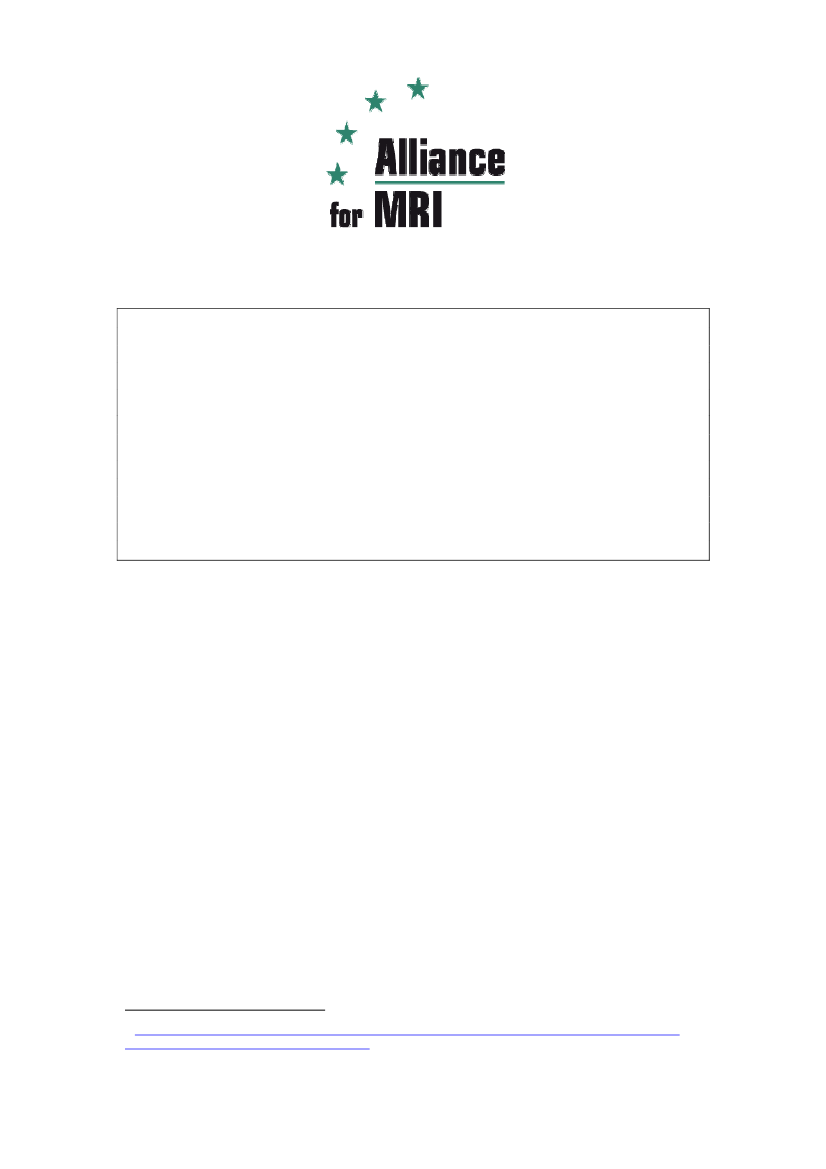Beskæftigelsesudvalget 2011-12
BEU Alm.del Bilag 83
Offentligt




November 2011The Alliance for MRI welcomes the Commission’s proposal to exempt Magnetic
Resonance Imaging (MRI) from the limit values set in Directive 2004/40/EC to
protect workers from electromagnetic fields (EMF Directive)
This derogation is necessary to ensure the unimpeded use of MRI so that
patients have access to the highest standard of care across Europe.
The safe use of this technology is highly regulated. Criteria have been set to
eliminate any danger to workers and patients.
MRI has been used for over 25 years, imaging up to 500 million patients
without evidence of harm to workers due to exposure to electromagnetic
fields.
The Alliance supports the adoption of guidelines to ensure that working
practices are in line with the latest technological developments.
On 14 June the European Commission adopted a proposal to revise the directive onprotecting workers from electromagnetic fields. The European Commission’sproposal includes a derogation for the medical and research use of MRI from theexposure limit values, which will ensure that this vital technology will continue to beavailable for all patients.This revision is a result of the concerns raised by the Alliance for MRI and arecognition by the European Commission that the current Directive severely curtailedthe use of MRI to the detriment of patients in Europe1.The derogation for MRI is required as the revised exposure limit values still curtail theuse of MRI in areas such as MRI-guided surgery (for example brain surgery) and inimaging vulnerable patients and children, where closer patient contact is required.Furthermore, new research and developments in MRI would be severely restricted,as would routine cleaning and maintenance of MRI equipment.It is important that the derogation covers all MRI activities, includingclinical use,
research, cleaning and maintenance.
In all those activities workers may beexposed to one or more of the types of electromagnetic field generated by an MRIscanner (static magnetic field, switched magnetic field gradients, radio frequencyfield) at similar levels as are encountered by healthcare workers when the system isin clinical use, with the result that the same exemption isneeded.
1 An Investigation into Occupational Exposure to Electromagnetic Fields for Personnel Working With and AroundMedical Magnetic Resonance Imaging Equipmentprepared for DG Employment and Social Affairs, April 2008 1
The Alliance for MRI represents workers who are exposed on a daily basis toelectromagnetic fields, as well as patients, researchers and scientists. The safe useof MRI is a key concern to all members of the Alliance for MRI.The safety of MRI is ensured through the established MR safety standard IEC/EN60601-2-33 which defines criteria for minimizing physiological effects due toexposure to time-varying electromagnetic fields for patients and workers. MRI is freefrom health risks associated with ionising radiation such as x-rays, which would formthe alternative to MRI in many situations.MRI is a diagnostic technique that uses radio and magnetic waves to produceimages of unrivalled quality, particularly of soft tissues that are not well depicted in X-rays. It is essential in the diagnosis and treatment of life-threatening diseases suchas cancer, heart disease and brain disorders. MRI is used in mapping brain functionsprior to surgeries for diseases such as epilepsy and to advance our understanding ofhow the brain works. New cutting edge diagnostic and treatment techniques such asMRI-guided surgery are constantly being developed leading to improved patientoutcomes.Europe is currently at the cutting edge of innovations in MRI technology, contributingsignificantly to the objectives of the EU’s 2020 strategy. The EU and member stateshave invested significantly2in MRI technology, given the potential it offers to thefuture of medicine and understanding of the human body. These investments mustno longer be jeopardised through the legal uncertainty caused by the currentlegislation.It will also be important that the Commission proposes a further postponement of thedeadline for implementation of Directive 2004/40/EC (originally set for April 2012),given that any revision of the directive will not be in place by that date.The Alliance for MRI welcomes the commitment by the European Commission andthe support of many members of the European Parliament to address to find asustainable solution for MRI in Europe.
Background on the Alliance for MRI
The ‘Alliance for MRI’ is a coalition of European Parliamentarians, patient groups,leading European scientists and the medical community, who together are seeking toavert the serious threat posed by EU health and safety legislation to the clinical andresearch use of Magnetic Resonance Imaging (MRI).The Alliance for MRI was officially launched in March 2007 in response to theimplementation of the EU Physical Agents 2004/40/EC (EMF) in April 2008. TheAlliance was founded by the European Society of Radiology, the EuropeanFederation of Neurological Associations and Dr. Swoboda MEP, Vice-Chairman ofthe Socialist Group in the European Parliament.In October 2007 the European Commission proposed the postponement of theimplementation deadline from April 2008 to April 2012 to allow more time for theevaluation of new data on EMF and its short-term effects on the human body. The 2 The EU has allocated €6 million through the 7thResearch Framework Programme to the furtherdevelopment of MRI, France and Germany have invested over €200 million in the state of the artNeurospinfacility.
2
Commission stated that it was never the intention of this Directive to impede thepractice of MRI and the European Parliament and the Council approved thepostponement.The Alliance is supported by:
27 leading Members of the European Parliament
János Áder (EPP) HU, Frieda Brepoels (EFA) BE, Derek Clark (EFD) UK, AlejandroCercas (S&D) ES, Jorgo Chatzimarkakis (ALDE) DE, Frank Engel (EPP) LU, RobertGoebbels (S&D) LU, Fran§oise Grossetête (EPP) FR, Richard Howitt (S&D) UK,Stephen Hughes (S&D) UK, Ville Itälä (EPP) FI, Anneli Jäätteenmäki (ALDE) FI,Philippe Juvin (EPP) FR, Eija-Riitta Korhola (EPP) FI, Peter Liese (EPP) DE,Elizabeth Lynne (ALDE) UK, Linda McAvan (S&D) UK, Miroslav Mikolášik (EPP) SL,Elisabeth Morin-Chartier (EPP) FR, Dr. Angelika Niebler (EPP) DE, Siiri Oviir (ALDE)EST, Antonio Panzeri Pier (S&D) IT, Frédérique Ries (ALDE) BE, Zuzana Roithová(EPP) CZ, Horst Schnellhardt (EPP) DE, Hannes Swoboda (S&D) AT (Foundingmember), Thomas Ulmer (EPP) DE, Derek Vaughan (S&D) UK, Dr. Anja Weisgerber(EPP) DE15 European and National patient groups
European Federation of Neurological Associations (Founding member); including theEuropean Parkinson's Disease Association, The European MS Platform and theEuropean Headache Alliance, The European Heart Network, Europa Donna, TheEuropean Patients Forum, The International Diabetes Federation – Europe,Alzheimer Europe, The WHO Collaborative Centre for Research, training andtreatment in Epilepsy, The Austrian Lung Association, The Austrian EpilepsyAssociation, Werkgroep Hersentumoren vzw (Belgian Brain Tumour Group),Epilepsy Centres of the Netherlands Foundation: SEINRepresentative Groups of Scientists
European Society of Radiology (Founding Member) and institutional members(below)The Wellcome TrustCancer Research UKEuropean Society for Magnetic Resonance in Medicine and Biology(ESMRMB)European Union of Medical Specialists (UEMS)European Brain CouncilLuxembourg Medical CouncilEuropean Institute for Biomedical Imaging Research (EIBIR)The Society and College of RadiographersEuropean Society for Therapeutic Radiology and Oncology (ESTRO)European CanCer Organisation (ECCO)European Federation of Organisations for Medical Physics (EFOMP)European Federation of Radiographer Societies (EFRS)
Institutional members of European Society of Radiology:
Société Fran§aise de Radiologie (SFR)Spanish Radiological Society (SERAM)Polish Medical Society of RadiologyNorwegian Society of RadiologyRoyal Belgian Radiological SocietyLuxembourg Society of Radiology
3
Deutsche Roentgengesellschaft - German Radiological Society (DRG)Radiological Society of the NetherlandsEuropean Society of Urogenital Radiology (ESUR)European Society of Thoracic Imaging (ESTI)European Society of Neuroradiology (ESNR)Croatian Medical Association & Croatian Society of RadiologyEuropean Society of Cardiac Radiology (ESCR)Italian Society of Radiology (SIRM)European Society of Breast Imaging (EUSOBI)Romanian Society of RadiologyDanish Society of RadiologyAustrian Radiologic Society (ÖRG)British Institute of RadiologySwedish Society of Medical RadiologyBulgarian Association of RadiologySociedade Portuguesa de Radiologia e Medicina NuclearCzech Radiological SocietySlovak Radiological SocietyFaculty of Radiologists, Royal College of Surgeons in IrelandEuropean Society of Head and Neck RadiologyCardiovascular and Interventional Radiological Society of EuropeThe Royal College of Radiologists
In addition, a number of individual scientists and patient group representatives havesigned up to the Alliance. Further information is available atwww.alliance-for-mri.org
4




